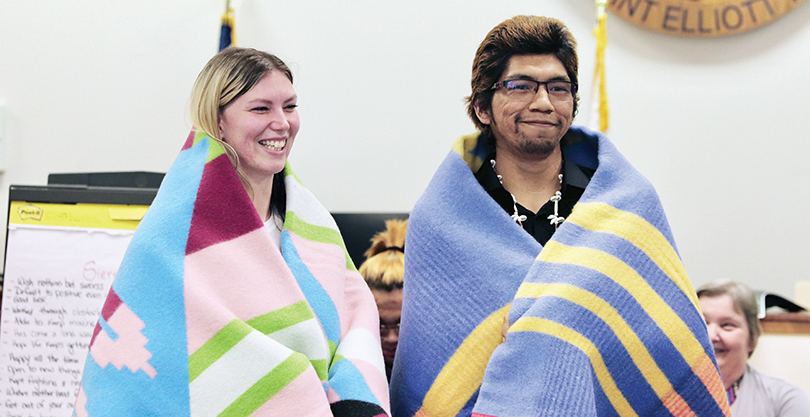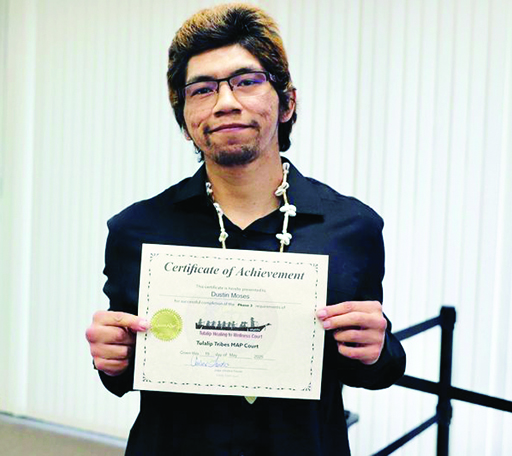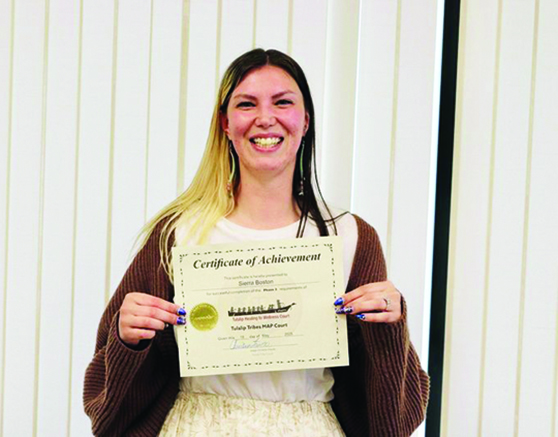
By Kalvin Valdillez, Tulalip News
The courtroom was packed wall to wall on the afternoon of May 15. At the center of the room were close to a dozen Tribal members, their chairs formed in a circle. And a look around the outside of the circle showed about thirty community members beaming with pride and happiness, wiping tears from their eyes, as they gathered to celebrate two individuals for overcoming what some would consider the near-impossible.
Said Wellness Court Interim Manager, Leora Jones, “Both Sierra and Dustin have been a part of the program since I started. To watch them grow in the program and use all the tools that were given to them and be successful in the program so they can be successful outside of the program, it’s been emotional. To watch two people overcome their struggles and barriers, it feels really good.”
“I’m super proud,” added Judge Christine Frausto. “They’ve worked so hard at everything they’ve done, and I’ve had the pleasure of watching them grow. They’ve become such a great support for their peers and for the program and I know they will continue to grow. For them to go through the program and do so well, it totally changed their lives. And it goes to show the strength of the program and that what we do works. They are the proof.”
A Quick Look Back
Back in 2017, the Tulalip Justice Department implemented a new program with the intention of saving lives. At the time, the program was met with some skepticism as there had already been a few failed attempts at drug courts on the reservation in previous years.
Attending one of the very first hearings for the new Healing to Wellness Court model, Tulalip News caught a glimpse at something that would ultimately change the lives of numerous Tribal members over the coming years. As the first few Wellness Court participants took the stand, they each shared some friendly banter with the judge while also giving an update on their lives. The judge then went over their personalized plans to recovery with each participant, discussing goals and setbacks. If they were in compliance, they received an incentive of their choosing. If they strayed from their plans, they were given an opportunity to explain what happened before receiving a sanction, which ranged from a writing assignment to additional jail time.
Though participants and courthouse staff could see the changes in the participants week after week, the community was still unsure how the Healing to Wellness Court would play out. Keep in mind, this was at the beginning of some of the bleakest times in Indian Country, as the death by opioids epidemic reached an all-time high of 72,000 people in 2017. And according to the Centers of Disease Control and Prevention (CDC), Native American communities were the most affected by this crisis.
The overall perception of the program began to change about a year-and-a-half after its inception, when Tribal member Verle Smith emerged victorious as the very first graduate of the Healing to Wellness Court model. At the time Verle shared, “If it wasn’t for the Wellness Court, I don’t know where I’d be – if I’d even still be here. They gave me the opportunity to experience something that works for my life. I didn’t know which way to turn, so I figured I’d try something different and I’m grateful for it. I want to thank the Wellness Court for it all. I now plan to go through the rest of my life bringing the next person closer to where they’re supposed to be, to where they’re needed.”
Verle kept his word. Throughout the past eight years, more and more Tribal members have found success with the Wellness Court. And one-by-one, the local recovery community has grown exponentially. And to this day, Verle can be spotted at recovery-focused events offering support to others and leading by example.
The Tulalip Recovery Community Grows
Fast forward to present day. Unfortunately, looking at things from a broad scope, not much has changed. Overall, it’s gotten worse as the opioid epidemic continues to be a major issue all across the nation. In 2017, there were about 15 opioid deaths per 100,000 population nationwide. That number jumped significantly, doubling to 31.3 deaths per 100,000 population in 2023. If we narrow that scope to just the American Indian/Alaskan Native community, there were 65 deaths per 100,000 population that same year, as this is the most current statistic by the CDC.
But what the Tulalip Justice Department is showcasing through the Healing to Wellness Court is that there is an upward trend of getting clean and sober locally. In fact, the Healing to Wellness Court has been a beacon of light for addicts looking to make a change. The program has impacted so many lives in a positive manner, that they were recognized on a national level, and held the honor of serving as a national mentor court for outside communities.
In addition to receiving a tailor-made plan to recovery, each participant must also complete a set amount of ‘give-back’ hours in the community. This is culture-focused and is perhaps one of the main reasons why the program has seen much success. The give-back hours help reconnect the people to their heritage and traditional way of life. It also provides an opportunity for them to reacclimate into the community, building bonds with not only fellow Wellness Court attendees, but also with tribal leaders, elders, and families. Wellness Court participants are often seen putting in work at events like Canoe Journey, Salmon Ceremony, and Smokehouse gatherings throughout their time in the program, as well as after successful completion. And every summer, the Recovery Resource Center organizes the Recovery Campout at Lopez Island. The number of participants for that outing has grown year after year, and a majority of those attendees also own a Healing to Wellness Court certificate of achievement of their own.
There are several Tribal departments that assist in the recovery journey for those in the Wellness Court program, including the Tulalip Police Department, the Healing Lodge, Family Haven, Family Services, and the Recovery Resource Center. During this time, many participants are able to find work within the Tribe as well. And with all hands on-deck, as long as the participant remains locked in, they are able to receive their certificates just 18-months after embarking on the red road. Which brings us back to the afternoon of May 15.
The Graduation Ceremony
The graduation kicked off with some words from the inner circle of the Wellness Court. Time after time, the current Wellness Court participants thanked Dustin and Sierra for their support both inside the courthouse and out in the community. Although they were happy to see the latest graduates’ success, the also expressed a bit of sadness to see them leave as they each had become a prominent voice in the program’s weekly talking circle.
Next, Sierra and Dustin’s families, friends, and various counselors and advisors took a moment to reflect on how far each of them have come over the past 18-months, while also commending them on their determination. No matter the amount of obstacles or setbacks, these two worked hard to attain and maintain their sobriety. They have found their true selves again and developed a deep appreciation for the culture and community. And most importantly, they have become a source of inspiration for others within the program.
“When it comes to this program, it’s working because we are working with participants at their level,” shared Leora. “We know they may be met with struggles, but we’re going to be here to help them. We sit down with them as a team. We have a judge, prosecutor, defense attorney, chemical dependency, mental health, we all sit at the table together and see how we can help them move forward. We get to know these people, we get to work with them, help them grow, and help them set long-term goals. Dustin and Sierra have come a long ways, not only in their sobriety but overall growth and they both have plans moving forward.”
Dustin and Sierra were blanketed and received their certificates to an uproar and near-deafening applause as the community celebrated their milestone achievement. With the program now complete, they are both looking to make a fresh start. Their eyes are set on the future as they each plan to reunite with their families. In the next coming months, Dustin will be heading to Yakima and Sierra plans on moving to Alaska.
Before the ceremony ended, both of the graduates shared a few closing remarks with the Wellness Court participants.
Dustin

forward. It gets better if you don’t put obstacles in front of
yourself, “ Dustin Moses.
First of all, I’d like to thank the court system for putting up with me for so long. It feels amazing that I found a program that will actually work for me and help me mentally. Going in and out of the court systems, it was hard, always being on the run.
Finding this program, at first, I didn’t know nothing about it. I was kind of skeptical when they told me about it. I was going to say no and go right back out into the streets after doing my jail time – but I’m glad I didn’t.
And these guys keep telling you, communication is key. It really is. It helped me. At first, I had a few speed bumps in the road in the first stages. Once I actually opened up and started getting vulnerable and asking these guys for help when I needed it, it helped me grow not only in the program but in my recovery. I’m glad to say today I’m celebrating 15 months clean.
It’s all thanks to the support that I got from everyone in here. Not only the court, but my family, friends. It’s been one hell of a journey. I just want to say keep moving forward. It gets better if you don’t put no obstacles in front of yourself.
Sierra

Love who you are,” Sierra Boston.
I as well want to thank the program. This is my third try. The first time I came in I felt like I was going to make it seem like a facade and run. I wanted to be here, but I was scared to face the trials and tribulations. The second time I was ashamed of who I was and embarrassed, so I showed up once and I ran again. I actually tried to disappear.
The third time this place, home, has saved my life. This will always be my home. The people and learning what a community is and a tribe, big or small, we’re not meant to be alone. And I really had to face myself to be able to face others in both good and bad times. I will always be hoping and praying that this journey continues for all of us.
It’s really hard to take care of others if you don’t take care of yourself. Love who you are.